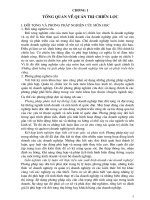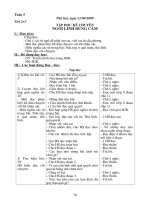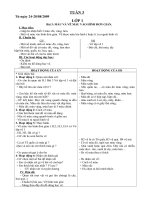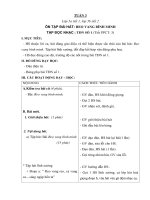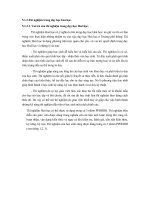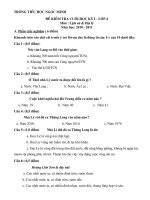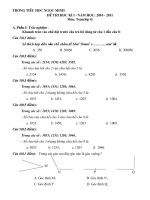- Trang chủ >>
- Mầm non - Tiểu học >>
- Lớp 5
5 1 3 tobys vacation
Bạn đang xem bản rút gọn của tài liệu. Xem và tải ngay bản đầy đủ của tài liệu tại đây (4.07 MB, 14 trang )
Suggested levels for Guided Reading, DRA,™
Lexile,® and Reading Recovery™ are provided
in the Pearson Scott Foresman Leveling Guide.
Toby’s
Vacattion
Vaca
Genre
Realistic
fiction
Comprehension
Skills and Strategy
• Setting and Theme
• Generalize
• Visualize
by Christian Downey
Scott Foresman Reading Street 5.1.3
ISBN 0-328-13509-7
ì<(sk$m)=bdfajh< +^-Ä-U-Ä-U
Reader Response
1. What part of California did Toby and his family visit?
What were some of the things he saw when he
arrived?
Toby’s
Vacation
2. Imagine that you are on one of the Channel Islands
with Toby and his family. Visualize yourself there, and
write down what you see.
3. On page 11 of the story, Toby and his family stand
on the headland of the island near their ferry. If you
don’t know what a headland is, can you guess from
the story? Write what you think the definition is.
Then, to be sure of the meaning, look up headland in
a dictionary.
4. The California islands are home to many plants and
animals that may soon be extinct. Think of ways that
humans can help preserve them and keep them in
good condition. List your ideas in a table like the one
below.
by Christian Downey
Editorial Offices: Glenview, Illinois • Parsippany, New Jersey • New York, New York
Sales Offices: Needham, Massachusetts • Duluth, Georgia • Glenview, Illinois
Coppell, Texas • Ontario, California • Mesa, Arizona
Toby and his parents decided to fly to California
for their vacation. Toby’s aunt lived in San Diego, in
the southern part of California. Toby couldn’t wait to
visit. He had never been out West. His mom told him
to pack his shorts, T-shirts, and sneakers. He also took
his bathing suit, because they would visit the Pacific
Ocean. Toby couldn’t wait to tell his friends that he
went swimming in the Pacific!
Every effort has been made to secure permission and provide appropriate credit for
photographic material. The publisher deeply regrets any omission and pledges to
correct errors called to its attention in subsequent editions.
Unless otherwise acknowledged, all photographs are the property of Scott Foresman,
a division of Pearson Education.
Photo locators denoted as follows: Top (T), Center (C), Bottom (B), Left (L), Right (R),
Background (Bkgd)
Cover: © Joseph Sohm; Visions of America/Corbis; 1 © Nik Wheeler/Corbis; 3 © David
Keaton/Corbis; 5 (B) ©Joseph Sohm; Visions of America/Corbis, (CR) © Macduff
Everton/Corbis; 6 © Nik Wheeler/Corbis; 7 © Kennan Ward/Corbis; 8 © Tim Laman/
National Geographic/Getty Images; 9 © Kennan Ward/Corbis; 10 (T) © Nik Wheeler/
Corbis, (C) © Ralph A. Clevenger/Corbis, (B) © George D. Lepp/Corbis; 11 (R) © Jim
Zuckerman/CorbiS, (L) © George H. H. Huey/Corbis; 13 © Neil Rabinowitz/Corbis; 14
© Dave Bartruff/Corbis; 15 © D. Robert & Lorri Franz/Corbis; 18 © W. Perry Conway/
Corbis; 19 © Catherine Karnow/Corbis; 22 © Jon Hicks/Corbis
ISBN: 0-328-13509-7
Copyright © Pearson Education, Inc.
All Rights Reserved. Printed in the United States of America. This publication is
protected by Copyright, and permission should be obtained from the publisher
prior to any prohibited reproduction, storage in a retrieval system, or transmission
in any form by any means, electronic, mechanical, photocopying, recording, or
likewise. For information regarding permission(s), write to: Permissions Department,
Scott Foresman, 1900 East Lake Avenue, Glenview, Illinois 60025.
2 3 4 5 6 7 8 9 10 V0G1 14 13 12 11 10 09 08 07 06 05
A beach in San Diego
3
As soon as they landed, Toby was amazed by what
he saw. His mom’s sister, Aunt Lee, drove Toby and
his parents to her house. Out the car window, Toby
saw tall buildings and palm trees. The roads were
wide, and he could see mountains far off in the
distance.
“Toby, look!” said his mother, pointing out of her
window.
Toby looked to where she had pointed and saw
the ocean. People were playing and swimming at
the beach. Toby couldn’t wait to run in the sand and
jump in the bright, blue water.
“Toby, do you want to check out some of the
islands along the coast?” asked his aunt.
“Of course!” answered Toby.
The next day, they set out on their island journey.
Aunt Lee told them about the islands as she drove.
“I’m taking you to see the Channel Islands,” she
said. “The Channel Islands are made up of eight
islands off the California coast, four northern islands
and four southern ones.”
“What’s on the islands?” asked Toby.
“All sorts of things,” answered Aunt Lee. “There
are plants and animals. There are many different
kinds of birds and fish. The islands are home to all
sorts of natural life. You can see for yourself, since
we’re almost there!”
The Channel Islands
Downtown San Diego, CA
4
5
The Channel Islands National Park
6
Toby and his family took a ferry to the islands.
A tour guide described the Channel Islands
National Park.
“The park is made up of five of the Channel
Islands,” said the tour guide. “They hold over
2,000 kinds of plants and animals. Many of those
can’t be found anywhere else in the world.”
“That’s amazing,” said Toby’s dad. “What are
some of the animals we might see?”
The tour guide replied, “On the islands there
are seals, sea lions, foxes, owls, and many other
kinds of animal life. Even though they’re located
close to some large California cities, the islands
aren’t very developed.”
“So nobody bothers the animals, right?” asked
Toby.
“Right,” said the guide. “It’s very important
that the animals and plants are allowed to grow
and live undisturbed.”
7
Their first stop was Anacapa, the smallest of the
northern Channel Islands. Anacapa was made up of
three very small islands, called islets. Toby stood on
the edge of one and looked out at the water.
“What’s that brown stuff over there?” he asked
his mother, pointing at the water.
“It looks like kelp. Seaweed.”
“Is it bad for the animals?” asked Toby.
“Not at all, it’s just a part of the environment,”
said his mom. “And kelp provides shelter for many
sea creatures.”
After they left Anacapa, Toby and his family went
to San Miguel Island and then stopped for lunch.
They still had a full day of sightseeing ahead of them.
Kelp
8
After lunch, Aunt Lee wanted to visit Santa Rosa
Island. Santa Rosa was the second largest of the
Channel Islands. Aunt Lee was excited to see the
trees. The island was known for its many kinds of
trees, including a native oak.
“Toby, they found human bones on this island
that were 13,000 years old. Can you believe people
were here that long ago?” Aunt Lee asked.
“And now we’re here too!” replied Toby.
“Think about how long these trees have been
growing,” said Aunt Lee.
“They look like the oak trees in your yard,” said
Toby. “Only much older!”
Santa Rosa Island
9
Western gull among coreopsis plants
Next they traveled to Santa Cruz Island, the
largest of the Channel Islands. The tour guide told
them all about their surroundings while they stood
on the headland by the ferry.
“This island has mountain ranges, ravines, tide
pools, and sea caves. On this island alone, there are
seventy-seven miles of coastline cliffs!”
“What kinds of animals are here?” asked Toby.
“So many kinds,” answered their guide. “There
are mammals, like deer and mice. We have over
one-hundred types of birds. There are also many
reptiles, like snakes and lizards.”
“Snakes?” asked Toby’s father, looking nervous.
Toby chuckled.
The guide continued, “Santa Cruz Island is also
home to many marine animals. There are dolphins,
seals, and sea lions. If you’re lucky, you may even
spot a whale near the shore.”
Island Fox
Spiny Lizard
10
11
As they walked around the island, Toby and his
family saw many different structures. There were
adobe houses and barns, where people and animals
used to live.
“People lived here many, many years ago,” his
aunt said. “Now the island is home to so many kinds
of plants and animals. I don’t want to leave!”
They had to leave, though. They boarded the
ferry again to go on to San Nicolas Island.
12
“This island was home to an entire group of
people in the 1800s,” said the guide as they passed.
“What happened to them?” asked Toby.
“They died off,” said the guide.
Toby was amazed that people had once lived on
the islands. They didn’t even have electricity! Years
ago, people had lived without so many things. Toby
wondered what it would be like to live on such a
small island.
13
Next they traveled to San Clemente Island, located
fifty-five miles out at sea. Toby’s mother was feeling
seasick from the long ferry ride by the time they
made it to the island. Toby’s father took him to the
water’s edge to explore.
“Look, Toby,” he said, holding up a shell. “This
was once part of a shellfish.”
“What’s a shellfish?” asked Toby.
“You remember the oyster we served you once?”
“Eww! You mean that slimy thing in a shell? It
had a vein in it. Gross!” said Toby.
“That vein was its sinew, ” laughed his father.
“You are better off eating fish sticks.”
Various kinds
of shellfish
14
A loggerhead shrike
Toby’s aunt told him that San Clemente was once
used by fishermen and ranchers.
“What’s that funny-looking bird?” Toby asked his
aunt, pointing up at a tall tree.
“That’s called a loggerhead shrike,” she told him.
“It’s an endangered species, which means there
aren’t many of them left in the world.”
Toby took pictures of the bird. He couldn’t wait to
show everyone at home.
15
They boarded the ferry and went past Santa
Barbara Island, the smallest of the Channel
Islands. It was beginning to grow dark, so they
went on to Santa Catalina Island, the only
island with permanent residents.
“A Native American tribe used to travel here
for trade many years ago,” the tour guide told
them. “Now conservationists work to save the
plants that grow here from extinction.”
“How can they be saved?” asked Toby.
The guide answered, “People work to keep
the island clean and get rid of weeds. They also
remove any animals that may hurt the land.”
“Is it okay to have so many tourists coming
to the islands?” asked Toby’s mom.
“As long as people treat the island with
respect, visitors are welcome,” said the tour
guide. “Just leave it like you found it, please!”
Avalon Bay is part of Santa Catalina Island.
16
17
They ate dinner at one of the local cafes and
walked around the island. It was much different
from the others they had visited. This island had
streets and shops. Toby thought it looked more like a
town than an island.
Night had fallen. On the way back to the ferry,
Toby saw a small cavelike hole by a big tree.
“What’s that?” he asked Aunt Lee.
“It looks like a fox’s lair. That’s where the fox lives
and hides from us!” she joked.
“Look,” said Toby’s father, pointing at the hole.
“You can even see little teeth marks, where an
animal gnawed at the ground.”
Foxes in their lair
18
They were all exhausted from their long day of
visiting the islands. When they got off the ferry, Aunt
Lee drove them to her house for the night. Aunt Lee
told Toby more about California.
“You know, Toby, there are islands in the
northern part of California too,” she said. “San
Francisco has Angel Island, Alcatraz island, and
others. Angel Island used to be a fishing and
hunting site. Now it is used by the Coast Guard.
And Alcatraz is pretty famous!”
Angel Island is in San Francisco Bay.
19
“Famous? How?” asked Toby.
“Alcatraz used to have a prison where dangerous
criminals were held. There are many books and
movies about it,” said Aunt Lee.
“Are there still prisoners on the island?” asked
Toby.
“No,” said his aunt. “Now the island is a historic
site. Visitors can go to see the empty prison.”
When they arrived at Aunt Lee’s house, Toby and
his family were ready for bed. Even though Toby was
tired, he had trouble falling asleep. He couldn’t stop
thinking about all that he had learned that day. He
loved seeing the islands and learning about their
past. He had never seen so many animals and fish
outside of a zoo or aquarium.
Alcatraz Island
Its famous prison is now a museum.
20
21
The next day they decided to go to the
beach. On the way, Toby’s mother reminded
him of the lesson that the tour guide had
taught them: visiting natural places is fine as
long as you are respectful.
Toby was already looking forward to going
home. He wanted to tell his friends about the
California islands. He hoped his photos would
turn out OK so that he could show everyone
what he saw. But first, he was going to the
beach to swim in the ocean!
22
23
California Coastal
National Monument
The California Coastal National Monument was
established in 2000. It includes 840 miles of coastline
between Oregon and Mexico. Many of the animals
that live along the coast are very rare. People can be
a danger to these animals. Humans who walk, swim,
or ride boats too closely can cause problems. It is up
to everyone to make sure that nature is protected
there.
Reader Response
1. What part of California did Toby and his family visit?
What were some of the things he saw when he
arrived?
2. Imagine that you are on one of the Channel Islands
with Toby and his family. Visualize yourself there, and
write down what you see.
3. On page 11 of the story, Toby and his family stand
on the headland of the island near their ferry. If you
don’t know what a headland is, can you guess from
the story? Write what you think the definition is.
Then, to be sure of the meaning, look up headland in
a dictionary.
4. The California islands are home to many plants and
animals that may soon be extinct. Think of ways that
humans can help preserve them and keep them in
good condition. List your ideas in a table like the one
below.
24
